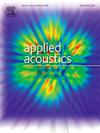Environmental sound classification using two-stream deep neural network with interactive time-frequency attention
IF 3.4
2区 物理与天体物理
Q1 ACOUSTICS
引用次数: 0
Abstract
Environmental sound classification (ESC) is crucial for understanding urban acoustic environments, and current classification methods cannot strike a balance between model performance and computational efficiency. In this paper, we propose a novel approach for modeling interactive time-frequency attention at different network levels using a two-stream deep neural network, namely ITFA-DNN. It uses two branches to capture time and frequency global dependencies at different layers of the network, respectively, introduces an inter-branch information interaction mechanism to enhance learning efficiency, and leverages depthwise separable convolutions to reduce model size. On two datasets, ESC-50 and UrbanSound8K, the proposed model achieves classification accuracy of 94.2% and 95.3%. It outperforms other models in ESC-50, and is comparable to state-of-the-art models in UrbanSound8K while reducing computational complexity by over 90%. Results from ablation experiments and visualizations further demonstrate that the proposed method effectively captures the global time-frequency dependencies of sounds in complex environments while improving computational efficiency. These highlight the superiority of the proposed method in environmental sound classification.
基于交互时频注意的双流深度神经网络环境声音分类
环境声分类(ESC)对于理解城市声环境至关重要,目前的分类方法无法在模型性能和计算效率之间取得平衡。在本文中,我们提出了一种使用双流深度神经网络(即ITFA-DNN)在不同网络级别上建模交互时频注意力的新方法。它使用两个分支分别捕获网络不同层的时间和频率全局依赖关系,引入分支间信息交互机制以提高学习效率,并利用深度可分离卷积来减小模型大小。在ESC-50和UrbanSound8K两个数据集上,该模型的分类准确率分别达到94.2%和95.3%。它在ESC-50中优于其他模型,并可与UrbanSound8K中的最先进模型相媲美,同时将计算复杂性降低了90%以上。消融实验和可视化结果进一步表明,该方法在提高计算效率的同时,有效地捕获了复杂环境中声音的全局时频依赖关系。这些都突出了该方法在环境声分类中的优越性。
本文章由计算机程序翻译,如有差异,请以英文原文为准。
求助全文
约1分钟内获得全文
求助全文
来源期刊

Applied Acoustics
物理-声学
CiteScore
7.40
自引率
11.80%
发文量
618
审稿时长
7.5 months
期刊介绍:
Since its launch in 1968, Applied Acoustics has been publishing high quality research papers providing state-of-the-art coverage of research findings for engineers and scientists involved in applications of acoustics in the widest sense.
Applied Acoustics looks not only at recent developments in the understanding of acoustics but also at ways of exploiting that understanding. The Journal aims to encourage the exchange of practical experience through publication and in so doing creates a fund of technological information that can be used for solving related problems. The presentation of information in graphical or tabular form is especially encouraged. If a report of a mathematical development is a necessary part of a paper it is important to ensure that it is there only as an integral part of a practical solution to a problem and is supported by data. Applied Acoustics encourages the exchange of practical experience in the following ways: • Complete Papers • Short Technical Notes • Review Articles; and thereby provides a wealth of technological information that can be used to solve related problems.
Manuscripts that address all fields of applications of acoustics ranging from medicine and NDT to the environment and buildings are welcome.
 求助内容:
求助内容: 应助结果提醒方式:
应助结果提醒方式:


